70mm is not dead; it just smells funny
|
Read more
at in70mm.com The 70mm Newsletter |
| Written and photographed by: Thomas Hauerslev | Date: 20.04.2008 |
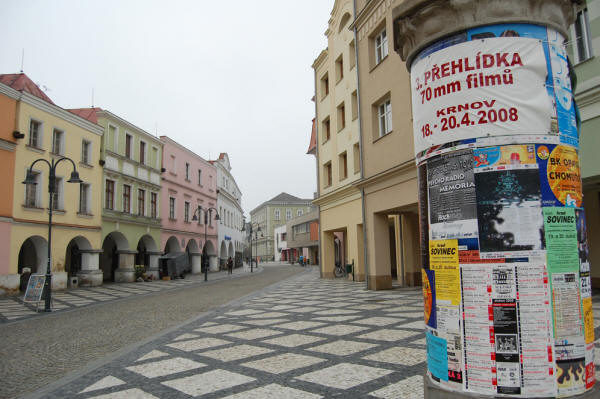 Main
street Krnov, with Hotel Pepa to the left Main
street Krnov, with Hotel Pepa to the leftBong! Bong! Bong! --- I looked at my watch: 6AM. I was being given a wake-up call by the bells of the local church. I came out of my sleepy fog and remembered that I was now here in Krnov, Czech Republic. It was just yesterday (Friday) that I’d spent getting here … a 6 hour straightforward journey becoming a 12 hour “epic” which would try the patience of anyone... The heavy fog in Prague airport the previous morning had been the culprit. Now, despite it all, I was here, and goal of my journey was a visit to the Kino Mir 70 cinema - the only 70mm theatre remaining in the Czech Republic which still shows 70mm films. I was here on the invitation of cinema manager Mr. Pavel Tomešek (4_), as well as the organizer of the event, Mr. Jakub Klima (23). Later this Saturday I would be giving my lecture titled "The Wonderful World of Film Formats". It’s my 30 minute presentation designed to give ordinary people an introduction to film formats and film presentation technique. I had arrived in Ostrava Airport the day before and was welcomed by Jakub Klima and Mrs. Jana ____, owner of the Pepa Hotel. They drove me to Krnov through a countryside which looked almost like Denmark, except for all the less-than-beautiful billboards. After checking in at the hotel and leaving my luggage, Jakub and I had walked to the cinema. It had become dark, past eight in the evening, and the city was quiet. A slight rain didn't matter much as we walked less than 5 minutes before we reached the cinema. |
More
in 70mm reading: KINO MIR 70'S 70MM SEMINAR KRNOV 3nd Seminar of 70mm film in Krnov 2008 Gallery: 3rd Seminar of 70mm film, Kino Mir 70, Krnov, The Czech Republic. First 70mm Seminar Second 70mm Seminar 4th 70mm Seminar Internet link: Kino Mir 70 Namesti Miru 14 794 01 Krnov The Czech Republic Telephone: +420 554 615 050 • Festival Page • KRRR! Facebook • TV program |
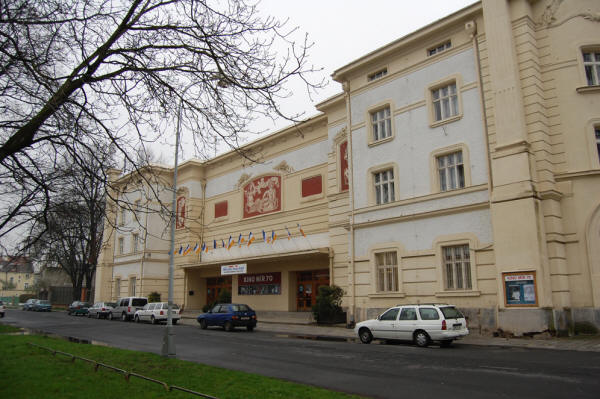 The
majestic
Kino
Mir 70 cinema in Krnov, Czech Republic. The
majestic
Kino
Mir 70 cinema in Krnov, Czech Republic.I noticed posters and advertising for the 70mm event everywhere. These guys are serious! The street in front of the cinema was crowded with cars - which is unusual according to Jakub. Inside, a large audience were watching the Jets and the Sharks – the singing ones, that is, and how they played it cool in "West Side Story”’s 70mm splendour. From a monitor in the foyer, staff could hear the soundtrack. It was a fairly new English 70mm print in colour from German 70mm aficionado & expert extraordinaire Jean-Piere Gutzeit in Berlin, Germany. As I arrived very late, and tired after 12 hours on the road, I had no wish to see "West Side Story”, but will look forward to seeing the new DTS 70mm print. The cinema is called "Kino Mir 70" was built around 1920 and is the only cinema left in The Czech Republic with 70mm projection equipment, Jakub tells me. The building is owned by the local county and they rent it to the city. It is now managed, with great enthusiasm, by Mr. Pavel Tomešek. From the outside, two sets of doors lead into the cinema and its magnificent and spacious foyer. Between the doors with wooden panelling, is the box office and concessions sale. |
|
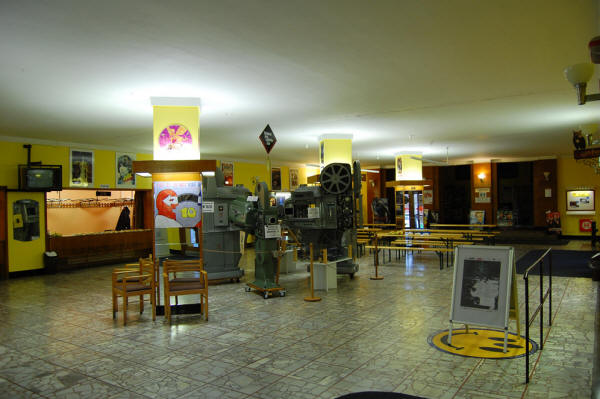 Kino
Mir 70 foyer Kino
Mir 70 foyerOpposite the box office is a cloak room managed by senior staff all dressed in cinema uniforms. To the left of the entrance is a grand staircase leading two floors up to the cinema. To the right the Kino Mir 70 hosts a DVD rental shop. Mr. Tomešek has his administration next to the DVD sales. Adjacent to the stairs is the registration desk for the weekend guests, where I also collected my weekend delegates pass. Brochures and flyers about the program were nicely organized in brochure holders and window sills. Brochures were in Czech; it would be nice if they were in dual languages next year. Everywhere you look in Kino Mir’s foyer, there is reference to 70mm. In the centre of the foyer is an exhibition of Meopta 70mm projectors and splicers. There is a significant smell of vinegar from the fading reel of 70mm film hanging on one foyer projector. It just assures me, once again, that 70mm is not dead, it just smells funny! |
|
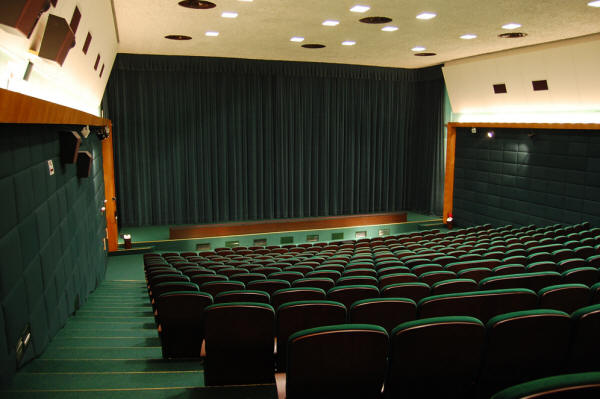 All
around the foyer, which could easily accommodate another cinema – are movie
posters from 70mm films presented in Czechoslovakia over the past years.
Pavel Tomešek is a dedicated 70mm film fan, and all conceivable and
available wall space has been covered with posters and 70mm stickers from
the past. It is striking how different pre-1995 posters look in Czech. A lot
of effort was put into making the movie posters be an art form. Jakub also
told about a book just recently published about Czech
movie poster art. All
around the foyer, which could easily accommodate another cinema – are movie
posters from 70mm films presented in Czechoslovakia over the past years.
Pavel Tomešek is a dedicated 70mm film fan, and all conceivable and
available wall space has been covered with posters and 70mm stickers from
the past. It is striking how different pre-1995 posters look in Czech. A lot
of effort was put into making the movie posters be an art form. Jakub also
told about a book just recently published about Czech
movie poster art.I take the stairs up to the cinema entry, which is up on the first level, and find even more Meopta projectors on display as I ascend. Staircase walls are also covered with posters for coming features, but also the occasional classic movie, all properly hung in glass frames. On the second floor, the staircase splits, leading up to the two entrances into the cinema. I enter from the rear of the cinema, and behold: a very nicely sloped cinema. Walls, carpets, seats and curtains are green. “The cinema is green, because it is good for the soul. It relaxes you” Jakub explains. And it looks very good, and as green is my favourite colour, I have to agree with him. |
|
 10
minutes intermission 10
minutes intermissionLess than a year ago, all the old seats were replaced by new seats. The cinema is a conventional “shoebox” shaped cinema with 14 curved rows with 322 seats and a 14 by 7 meters wide curved screen, which nearly covers the end wall. It is pleasingly dimensioned, I feel. Underneath the projection room window, is a Meopta control panel, which allows the projectionist to remotely control focus and image position (framing), as well as house lighting, of course. In the front of the screen there is a stage big enough for live performances. The first row of seats is also not too close to the screen. The view of the auditorium from the screen end of the cinema is striking. |
|
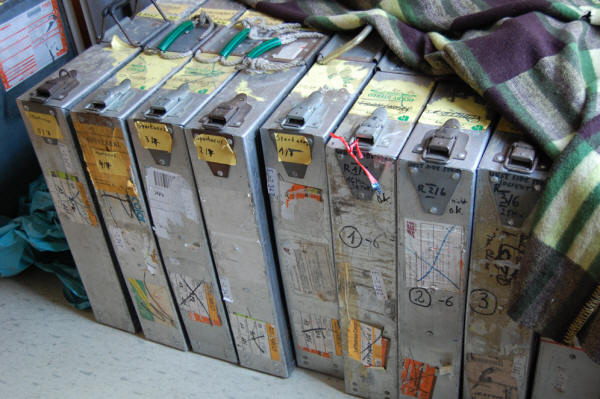 Standard
70mm transportation cans used since the late 1950s. Standard
70mm transportation cans used since the late 1950s.On my way up to the cinema I had noticed a door, which turned out to be the gateway to the projection room. And sure enough, the number of 70mm reels and cans reveals we are on the right path, and shortly I am in projection. Nearly a square room, 4 machines are pointing towards the screen. In the middle of the room, a cabinet with lenses, and in the rear of the room, the rewind table. An unusually ergonomically-friendly rewind desk, as it was sitting on the floor, so the projectionist doesn’t have to lift the heavy 70mm reels so much. Walls are covered with posters and notes for the projectionists. I am introduced to Jan and Petra who are on duty today. They don’t speak English, so Jakub is my guide and translator. A large rack with sound equipment tells me this is a state of the art cinema. |
|
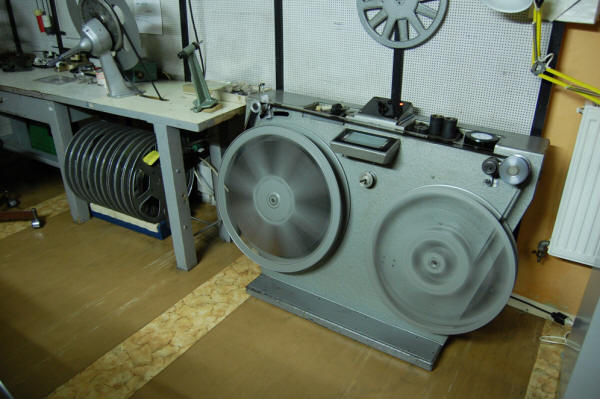 Rewind
tool for 70mm Rewind
tool for 70mmThe projection room is equipped with two Meopta UM 70/35XB 70mm machines and two Meopta Meo5XB projectors and a Meopta Meo II. X for 16mm film. An impressive array of machines in a fairly small projection room. The Kino Mir 70 is equipped with a Dolby CP65, DA20 and a SA10 to play Dolby Digital EX. Two readers for DTS 70mm have been bought already and are ready to be installed with their DTS XD10 player. Speakers are from Kelonic Cinema Sound and they have 3 stage channels, plus subwoofers, and 16 effects speakers. The Kino Mir 70 boldly believes in 70mm, and all this in a city with only 27.000 inhabitants. |
|
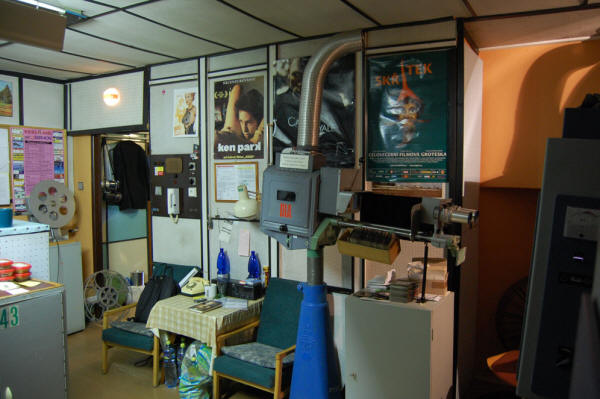 The
projection room looks like any projection room I have come across the past
30 years. There are film clips on the walls, sound loops ready to be used to
set up sound, posters, calendars with nudes, dimmed light, “that smell” and
sound of film passing over sprockets, xenon cooling fans, and the light
coming out of the machines. The Meopta UM 70/35XB is a very quiet machine,
even with air cooling of the gate. The Kino Mir 70 still does changeovers,
and 70mm is no exception. I noticed the Polish and DDR prints had square
motor marks and circular change over marks. Subtle differences. At present
there is not room for a platter system without removing some equipment. The
projection room looks like any projection room I have come across the past
30 years. There are film clips on the walls, sound loops ready to be used to
set up sound, posters, calendars with nudes, dimmed light, “that smell” and
sound of film passing over sprockets, xenon cooling fans, and the light
coming out of the machines. The Meopta UM 70/35XB is a very quiet machine,
even with air cooling of the gate. The Kino Mir 70 still does changeovers,
and 70mm is no exception. I noticed the Polish and DDR prints had square
motor marks and circular change over marks. Subtle differences. At present
there is not room for a platter system without removing some equipment. |
|
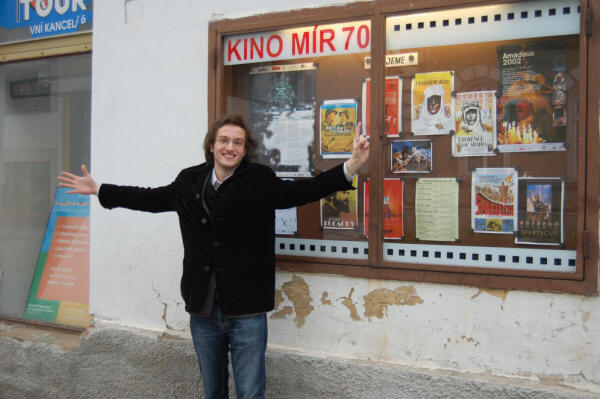 Jakub
on main street with 70mm weekend poster display Jakub
on main street with 70mm weekend poster displayJakub and I leave the Kino Mir 70 to go back to the hotel and have supper and an informal meeting about festival planning. Jakub Klima, 23 and enthusiastic co-organizer of the 70mm weekend tells me how difficult it is to find 70mm prints. Czech film distributors do not have many 70mm prints left and seems to be largely uninterested in the endeavour in Krnov. There are some private collectors in the old east, but they are not interested in lending out their 70mm prints. We discuss how to address the movie companies and Hollywood Classics. I encourage him to continue and build up a network across Poland, Hungary, and Romania etc, to exchange information and bring out the old 70mm films again. I am told the first-ever 70mm film the Kino Mir 70 ran was "Those Magnificent Men in Their Flying Machines" on 23. May 1969. Maybe they can show it again next year in the new DTS 70mm print from Fox? |
|
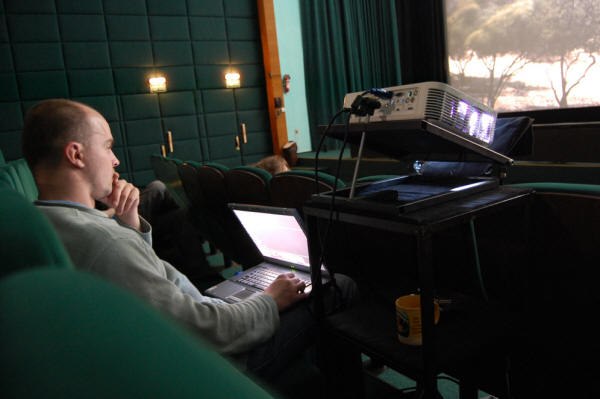 "On
the Fly" subtitles from the first row "On
the Fly" subtitles from the first rowDespite the difficulties in obtaining prints, Jakub did manage to make an interesting program for this year’s event. "Battle of the Bulge" a very red incomplete English 70mm print with Czech subtitles. "Pugachev" a Russian blow up with original sound and Czech subtitles "West Side Story" a newish English 70mm print with Czech subtitles "Hauptmann Florian von der Mühle" East German DEFA 70 version with Czech subtitles "Kazimierz Wielki" Polish version with Slovakian subtitles "Lawrence of Arabia" a newish English 70mm print with Czech subtitles "Spartacus" (Stanley Kubrick, 1960, English version, German and Czech subtitles "Amadeus" English 70mm blow-up with Czech subtitles |
|
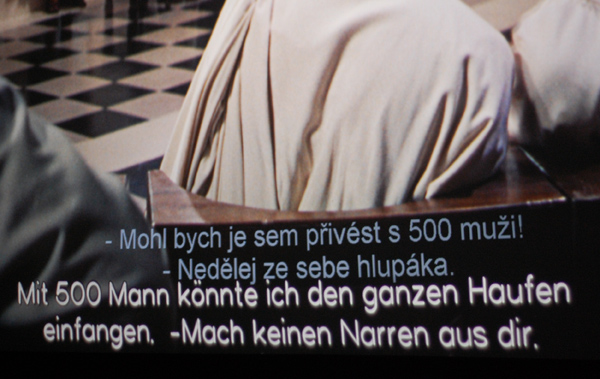 Two
sets of subtitles. Laser edged German subtitles and super imposed Czech
subtitles on top of them. Two
sets of subtitles. Laser edged German subtitles and super imposed Czech
subtitles on top of them.For “West Side Story”, “Lawrence” and “Spartacus” the Kino Mir 70 superimposed Czech subtitles live during the film. This was done from the first row with a digital projector and a laptop. During the film one of the staff was sitting and advancing the subtitles as the film ran. Almost a historical nod to the Cinerama operator who controlled the three projectors of the cinema when that format came out. The subtitles were lifted from a DVD, so I was told. “Spartacus” had German subtitles and on top of them, the improvised Czech subtitles. Showmanship the Czech way. I only saw two films this weekend because of time restrictions. I settled for the DEFA 70 "Hauptmann Florian von der Mühle" from DDR and the Polish blow up "Kazimierz Wielki". |
|
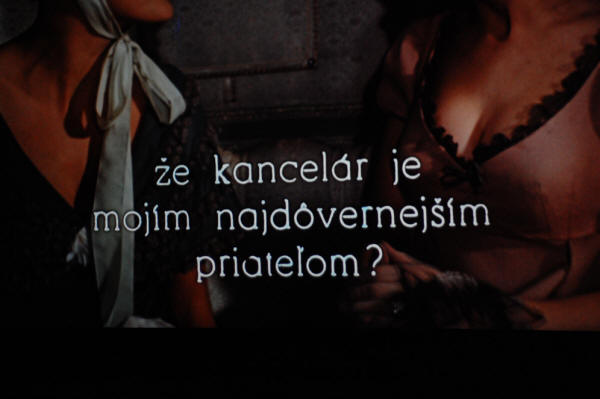 Three
lines of subtitles in "Hauptman" Three
lines of subtitles in "Hauptman"“Hauptman” was a strange experience of Chaplin-Keaton like comic, bad acting and lack of directing. I understood very little of the dialogue. It was a costume piece set around the days of Napoleon and Florian's race to get some money back. The colours of the vintage 70mm print still held up, primarily because it was NOT printed on Eastman stock. I suspect it was Orwo or Agfa Colour. Most of the sound was likely re-dubbed in a studio, as it had this very odd and stagy quality to it. Did not sound natural at all, and sometime even out of synch. I wonder what Manfred Krug; the leading actor is doing today. It would be interesting to hear about the filming of that film. "Kazimierz" was better, although I didn’t understand any of that at all, except perhaps, the story line is about the old king on his death bed thinking back on his life. Set in the 14th century, it featured spectacular photography and a very good sound space with directional dialogue. As it was a blow up, the images were quite fuzzy from time to time. The blow up process also revealed a less-than-clean laboratory, as all the dirt and hairs turned up as white specs throughout the purple faded film. The acting and direction - I felt - was much better compared to the DDR production. A little over two hours, it felt longer, but it had absolutely great set pieces and spectacle with burning villages, a cast of several hundreds and lots of castles. My Polish friends must forgive if I have missed the narrative completely. |
|
 Projectionist
Jan is looking out of the projection room Projectionist
Jan is looking out of the projection roomOverall, the projection quality is very good with the changeovers hitting the right spot every time. The image would benefit with some new projection lenses. Light intensity and focus could be improved, but I am sure they already have that in mind for future improvement. The nature of the 70mm prints varied from print to print. Pavel and Jakub told me this particular print of “Amadeus” had been shown some 4 times a day for a full year in Prague, during the original release. That is around 1400 passes through the projector, which meant that this 70mm print, which still has GREAT colour, is totally ruined, in terms of sound. The perforations are weakened and sometimes torn almost everywhere, and the magnetic soundtrack has peeled off throughout. In fact it is so ruined, that several reels are unprojectable and have to be replaced by 35mm here and there. I managed to get some of the bad pieces for my collection of 70mm clips. A rare treat, as I ran “Amadeus” for 16 months, 3 times a day when it was released 20 odd years ago. One of my favourite films of all time. My cinema even hit Variety’s news, when we rejected Milos Foreman mid-performance entry, when he asked permission to gain audience reaction. |
|
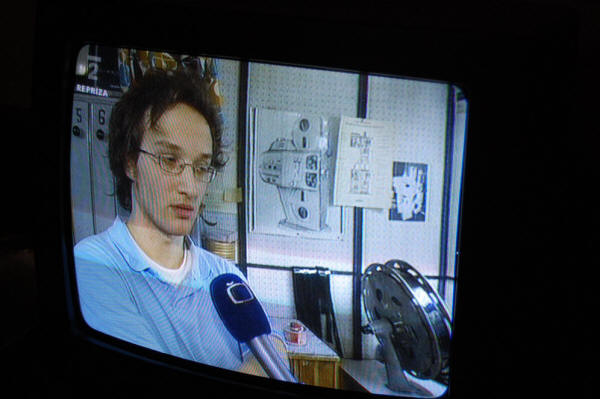 Jakub
made it to the national TV news about his 70mm festival Jakub
made it to the national TV news about his 70mm festivalBetween the two films I saw, Jakub had arranged some sort of TV interview between him and me. I never understood the purpose, but I played along as good as I could. Maybe it will turn up as headline news? Following the two films I saw, I was ready to present “The Wonderful World of Film Formats” in English to a Czech audience. Pavel felt it should be translated as I went along, but that idea had to be abandoned at the last moment because the translator didn’t show up. Jakub introduced me in Czech and the lecture played for around 40 minutes including the Dolby Stereo “Listen” demonstration short film after the last slide. Some people came up to me afterwards and said they liked it. |
|
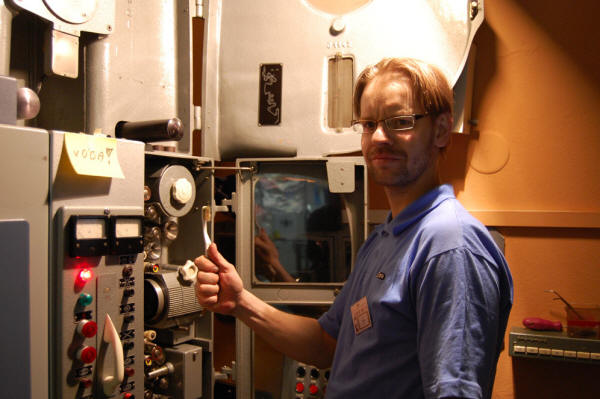 Projectionist
Jan Projectionist
JanI discovered how few people actually understand and speak English in this part of the world. Being a neighbour to Germany and Poland, many Czech people from Krnov understand and speak both German and Polish. Films are generally shown in their original version with subtitles. Children’s films are dubbed, as they are in most territories. Despite the language barriers, 70mm film seems to unite people. This year the Kino Mir had guests from Poland, Slovakia, Austria, Germany, Holland and Denmark. Very impressive, as Krnov is not exactly an easy place to visit. Jakub also told me they have guests mainly from Krnov, Ostrava and Brno, but also from Prague. The festival has its own Festival Page with impressive animations, but for a foreigner, the English language information is tricky to find, and once found, it is hard to read. Jakub assures me the web site will be improved, as there is already interest in doing a fourth festival in 2009, but the decision has not yet been taken. A lot of natives propose the Kino Mir 70 should show “this film” and “that film”, so the interest is there to continue to show 70mm film. |
|
 Projectionist
Petra Projectionist
PetraI felt the festival was well received by the audience, and surely “Lawrence” Saturday evening was a crowd pleaser and actually was the official Czech premiere. Until now, it had only been seen on TV screens. I counted at least 120 people in the cinema during the film. For “Hauptman” in the morning, I counted around 54 guests. Most, if not all film were introduced, mostly in Czech, and I suggested to Jakub to bring a short summary in English next year, since there were international guests. The soundtrack of “Lawrence” had a lot of tape hiss in the quiet scenes. Whether this was because of the lacking Dolby noise reduction or not, I don’t know. |
|
 Mr. Jakub Klima
and Mr. Pavel Tomešek with the new DTS 70mm reader. Mr. Jakub Klima
and Mr. Pavel Tomešek with the new DTS 70mm reader.The minor things with the web site, lens issues, and tape hiss in “Lawrence”, cannot overshadow the enthusiasm they are showing in Krnov. They are doing a marvellous job at the Kino Mir 70 keeping the best movie experience alive by waving the 70mm flag. I can only recommend they continue as long as there is an interest from the audience. It’s an example of how a few individuals can make a difference. If it wasn’t for Pavel and Jakub, there would be no 70mm in the Czech Republic. I went home Sunday around noon with a backpack full of 70mm clips, posters and good memories. Thank you for the hospitality and best wishes for the future. Thomas Hauerslev, Ostava Airport, 20 April 2008. |
|
|
Go: back
- top -
back issues
- news index Updated 22-01-25 |
|
